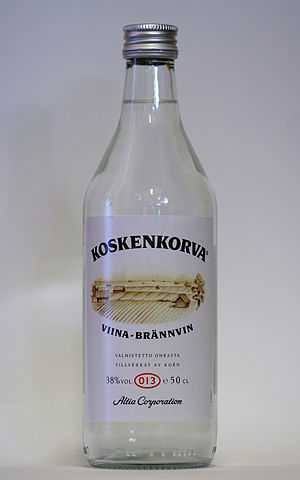Koskenkorva Viina

Koskenkorva Viina (also known simply as Koskenkorva, or Kossu) is the most common clear spirit drink (38%) in Finland, produced by Altia in the Koskenkorva distillery in Ilmajoki and bottled in Rajamäki.[1]
The grain (barley) alcohol is produced using 200-step continuous distillation designed to produce high-purity industrial ethanol. The drink is produced by diluting this alcohol with spring water and a very small amount of sugar. Although commonly called a vodka in English, in Finland it is not called a "vodka", but viina (see brännvin), although the word "vodka" is found in the label due to EU regulations.
Besides the standard 38% near-unflavored there are several variants of Koskenkorva on the market, most notably the famous Salmiakki Koskenkorva, better known as Salmiakkikossu or Salmari, which is salmiakki-flavored. Another variant is the same Koskenkorva with rye instead of barley, marketed under the same concept as Koskenkorva Viina Ruis. There also exists a vanilla variant called Vanilja Koskenkorva. The Koskenkorva Vodka is the same drink, but with 40% or 60% alcohol instead of the traditional 38%, as this brand is intended for foreign markets. Finlandia Vodka, a vodka classified as "imported premium", is the same as Koskenkorva 40%, except that sugar is not added. Altia sold this brand, intended for foreign markets, to the American Brown-Forman Corporation, but remains the sole producer of Finlandia Vodka at least until 2017.
A new design for the Koskenkorva Viina bottle was introduced in 2008. It has a white label, with KOSKENKORVA in black and VODKA below in grey, and a drawing of a scenery of fields with barns on them in light brown. The product number in the Finnish Alko, 013, is prominently displayed. This design line goes through the whole range of products.
Kossu is at its best when cold, but can be also mixed for example with Coke (which is then called "Kossukola"), with carbonated water ("Kossuvissy"), orange juice ("screwdriver"), energy drink ("Kossu Battery" or "Virtanen") or certain (hard) salty liquorice candies (Salmiakkikoskenkorva, Salmiakkikossu, Salmari). The last is often made by mixing ground Turkinpippuri (Turkish pepper) with kossu, though other candies of similar type are also a possibility and there also exists a ready salmiakki mixer for this particular purpose.[2] Another way of enjoying kossu, which has gained popularity recently, is mixing ground Fisherman's Friend lozenges to the drink. The resulting cocktail is known as "Fisu" (Helsinki slang for "fish").
Altia is owned by the state of Finland. When the government considered selling the corporation, a popular movement grew to oppose this.
Trivia
- Koskenkorva is a small village – that belongs to municipality of Ilmajoki – in Finland that translates as "(area) by the rapids". The folk etymology "rapid's ear" is based on the fact that korva also means "ear".
- The original name of the drink was Koskenkorvan viina – notice the genitive 'n' – "liquor of Koskenkorva". The name was changed recently into Koskenkorva viina "Koskenkorva liquor". Furthermore, even older labels had the original name in the partitive as KOSKENKORVAN VIINAA "(some) liquor of Koskenkorva".
- Irwin Goodman's song repertoire included "Koskenkorvassa" ("In Koskenkorva"), where nearly every line is a double entendre interpretable as either praise to living in Koskenkorva village or being drunk of Koskenkorva Viina.
- In the song The Land Of Ice And Snow, Timo Kotipelto, the vocalist of the Finnish heavy-metal band Stratovarius, describes Finland as the land "where Koskenkorva flows".
- The instrumental 0132 by also Finnish band Sentenced was composed to allude the hazy feeling after drinking Koskenkorva. The name itself is the product code for the drink.[3]
References
- ↑ Isola, S: Sauna, Grit, Guts & Kossu, p. 60-67, Welcome to Finland, Spring-Summer 2007
- ↑ Apteekin salmiakki mixer
- ↑ http://mhs.fi/sentenced/?action=kysymykset&t=700&hakusana=
External links
| Wikimedia Commons has media related to Koskenkorva Viina. |